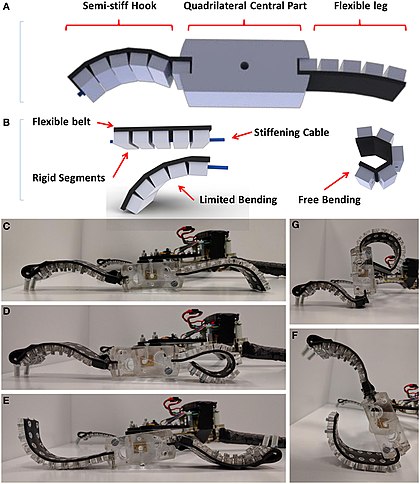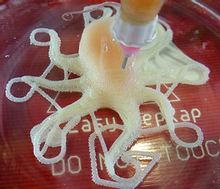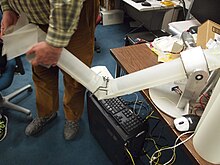Soft robotics
For example, rigid-bodied robotic arms can employ soft end effectors to gently grab and manipulate delicate or irregularly shaped objects.[3] Most rigid-bodied mobile robots also strategically employ soft components, such as foot pads to absorb shock or springy joints to store/release elastic energy.[6] Plant cells can inherently produce hydrostatic pressure due to a solute concentration gradient between the cytoplasm and external surroundings (osmotic potential).[7] The following equation[8] models the cell volume change rate: This principle has been leveraged in the creation of pressure systems for soft robotics.This SCM process is utilized in the production of mesoscale robots as the polymer connectors serve as low friction alternatives to pin joints.[15] A wide range of fully functional soft robots have been printed using this method including bending, twisting, grabbing and contracting motion.[44] Soft robots may also be used for the creation of flexible exosuits, for rehabilitation of patients, assisting the elderly, or simply enhancing the user's strength.[46] The team set out to design a soft robot that would mimic a lamprey or cuttlefish in the way it moved underwater, in order to efficiently explore the ocean below the ice layer of Jupiter's moon, Europa.In 2021, scientists demonstrated a bioinspired self-powered soft robot for deep-sea operation that can withstand the pressure at the deepest part of the ocean at the Mariana Trench.[47][48][49] In 2021, a team from Duke University reported a dragonfly-shaped soft robot, termed DraBot, with capabilities to watch for acidity changes, temperature fluctuations, and oil pollutants in water.[68][69] The broad class of materials often contain sensing abilities that are intended to reproduce the capabilities of human skin to respond to environmental factors such as changes in heat and pressure.[72] The successful combination of flexible and stretchable mechanical properties with sensors and the ability to self-heal would open the door to many possible applications including soft robotics, prosthetics, artificial intelligence and health monitoring.The tendency of polymeric materials to turn brittle at cooler temperatures is in fact thought to be responsible for the Space Shuttle Challenger disaster, and must be taken very seriously, especially for soft robots that will be implemented in medicine.A ductile-to-brittle transition temperature need not be what one might consider "cold," and is in fact characteristic of the material itself, depending on its crystallinity, toughness, side-group size (in the case of polymers), and other factors.[81] The 2018 animated Sony film Spider-Man: Into the Spider-Verse features a female version of the supervillain Doctor Octopus that uses tentacles built with soft robotics to subdue her foes.In episode 4 of the animated series Helluva Boss, inventor Loopty Goopty uses tentacles with soft robotics tipped with various weapons to threaten the members of the I.M.P into murdering his friend, Lyle Lipton.


roboticsrigid linkshydrostatic pressurefluid flowhydraulic conductivityosmotic potentialarachnid locomotionEmbedded hardwarecarbon fiber reinforced polymer3D printingRobocastingshape memory polymersglass transitionelectrostatic forceDielectric Elastomerhigh-voltageelectric fieldWeibull statisticscrosslinked polymersglass-transitionShrinky Dinkspolystyrenepolyurethanepolyethylene teraphtalatepolyethyleneoxideShape memory alloysPneumatic artificial musclesstretch sensorscontrol systeminvasive surgeryCollaborative robotslampreycuttlefishbioinspiredfor deep-sea operationMariana Trenchdeep-sea explorationenvironmental monitoringArtificial muscleArtificial musclesmuscleactuatorspneumaticpower-to-weight ratioemerging technologyremote sensedwearabletactile sensorhydrogelElectronic skinflexiblestretchableself-healingtactile sensingfatigue limitductile-to-brittle transitionSpace Shuttle Challenger disasterBig Hero 6Baymaxhealthcare industryChris Atkeson'sCarnegie Mellon'sRobotics InstituteDoctor OctopusHelluva BossArticulated soft roboticsOctobot (robot)Bio-inspired roboticsBionicsBioroboticsHome robotRobotic materialsSoft Growing RoboticsMagnetic slime robotWetware computerBiosensorRobotic sensingBibcodeLaschi, CeciliaNatureCiteSeerXIEEE Transactions on Dielectrics and Electrical InsulationUniversity of British ColumbiaAdvanced MaterialsUniversity of GlasgowCalifornia Institute of TechnologyThe TartanCarnegie Mellon UniversityOutlineGlossaryHistoryGeographyHall of FameEthicsCompetitionsAI competitionsAerobotAnthropomorphicHumanoidAndroidCyborgGynoidClaytronicsCompanionAutomatonAnimatronicAudio-AnimatronicsIndustrialArticulatedDomesticEducationalEntertainmentJugglingMilitaryMedicalServiceDisabilityAgriculturalFood serviceRetailBEAM roboticsCloud roboticsContinuum robotUnmanned vehicleaerialground